June 25th, 2024
It's already halfway through 2024. It feels like the year just started, but I guess that's because summer is finally here. It's always hitting 80 degrees every single day. Boo, I hate summer.
Anyways, this month didn't have much happen. I did win a couple of auctions.
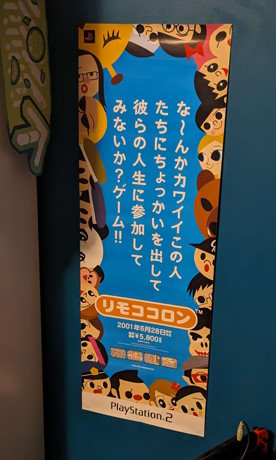
I got my first poster. It's a poster for Rimokokoron. It's not a B2 poster, so the shipping wasn't a billion dollars. It was rather cheap since nobody cares about this game but me. I hung it up next to my PC. The text on it was also used in the game's commercial.

I finally got the Samba de Amigo maracas. It's a boxed unit which came with everything but the mat and manual. I bought this soon after I got Samba de Amigo. This was shipped over surface since the box is as wide as my own shelf!
The unit comes in three pieces: the sensor bar and two maracas. The bar connects to the Dreamcast and the maracas connect to the bar. The maracas contain a speaker below which output a sound that the bar picks up to determine the position. The macaras themselves have a physical spinner that determines when you shake it.
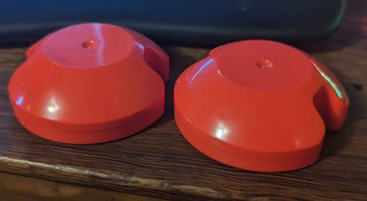
The maracas also come with little shakers that give the maracas their sound. They're a little loud. Thankfully, there is the option to unscrew them from the maracas to play mute.
There are a few limitations to it. You have to play extremely close to the bar so it can accurately pick up the sounds from the maracas and you have to play with clothes that don't get in the way of the bar or maracas. The bar also doesn't include VMU ports, so you'll also have to connect a seperate controller for save data.
A full combo with the controllers!
In the game, there's some trial and error with the settings too. You'll have to input where your TV is relative to you and then input how tall you are in game. Once all the settings are correct and you play within the limitations in the last paragraph, it's fun to play.
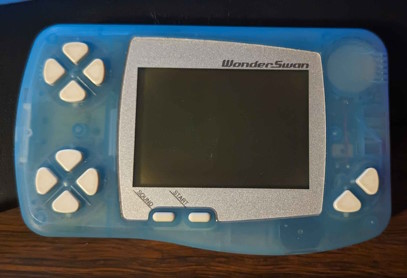
I got a WonderSwan! I wanted one for a while, but these consoles usually get sold without the detachable battery terminal, which is why I didn't bother until now. This one was listed as untested junk and I bought it with little to no competition. The system is one of the summer variants released in 1999, named Soda Blue. The color is more like a sky blue.
I thought that I would atleast get some boot screen without a game, but nope. It won't show anything except the bottom interface. Atleast now I know that it didn't go through battery corrosion. I'll get a game soon, but it should be one I'm interested in.
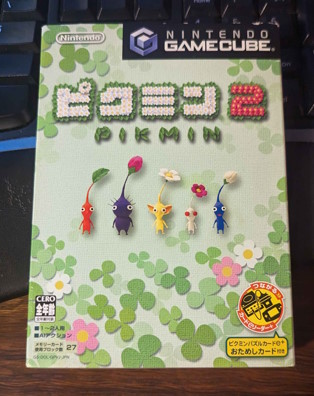
I also won Pikmin 2. I haven't actually played it yet as I'm not done with Pikmin 1.
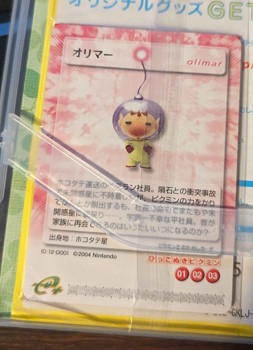
The game still has the e-reader cards that it comes with, which the international versions lack. It appears that these cards, named Pikmin Puzzle Card e+, unlock levels for minigames that can be sent to the GBA. It doesn't appear that any of these minigames affect the main game itself.
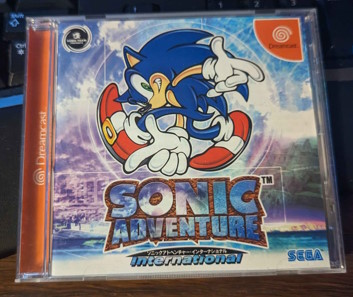
Sonic Adventure International is my next Dreamcast import. This game was pretty cheap. I think both the International and the original Japanese version don't really go for that much.
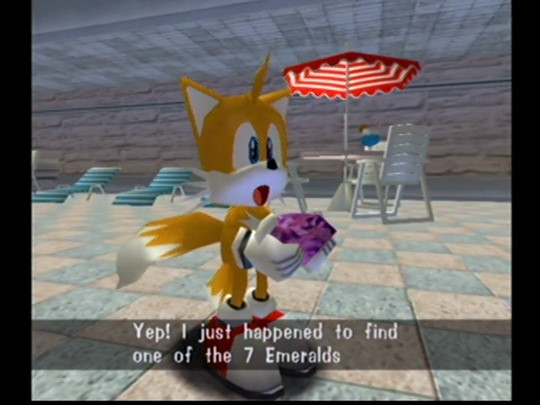
This is the International version, which was a re-released version that contains all the changes from the English releases. While the game is still region-locked, it retains the English script and voice acting, so it's a good subsitute for an American copy. As the International version replaced the original version, it's probably easier to find that version rather than the original Japanese version.
I've played a bit of it and had fun. I'm thinking about importing Adventure 2, but I'm not sure if the Japanese release retains the English options, so who knows?
I just got something for my PS2 I didn't think I could ever own.
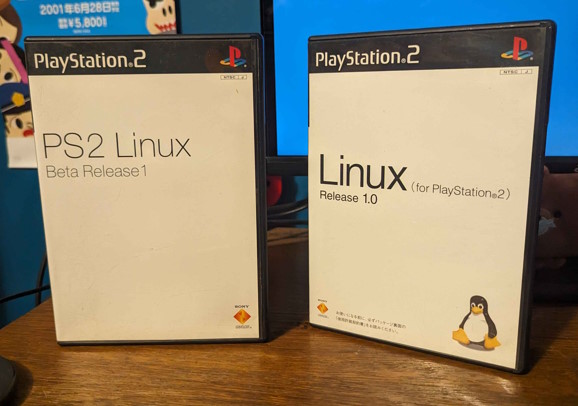
This is PS2 Linux. This was part of a set that Sony released which allowed users to install Linux to their PS2. This is the most expensive PS2 game I bought, being $30 USD in total.
Yahoo Auctions recommended me an auction for the Beta Release 1 disc, which I bid on. Shortly after, a store listed both the Beta Release 1 and Version 1 install discs for only $30! I knew damn well I was NOT winning that auction, so I bought them both before the auction ended. I was right, the auction was a loss, but the final price for the single Beta Release 1 disc costed more than how much I paid for both versions. Very lucky!
PS2 Linux was released online-only in a kit containing the install discs, PS2-branded USB keyboard and mouse, exclusive VGA adapter, and a PS2 hard drive with network adapter. Japan got a preview of Linux with the Beta Release before everyone got 1.0. Once the kit upgraded to version 1.0, early adopters were able to purchase the 1.0 install discs for 1,500 yen.

As PS2 Linux was a very limited release, complete kits go for hundreds online. The discs seem to go for only $40-60 though and are the only things you really need. While the discs are region locked, the Japanese discs can be used in English.
An exclusive VGA adapter was included in the kit and is the default video output for Linux, but there are options to use TV video modes instead. The launcher and OS have hidden options to load up in NTSC or PAL mode rather than VGA, allowing users to use a TV instead of a monitor. Around the kit's release, the adapter required monitors that used Sync-on-Green, which many monitors at the time didn't support, so the TV mode was a backup incase you couldn't use a monitor. The only downside is that you're seemingly locked to 640x480 and the quality isn't as good as an actual monitor, but what did you expect?
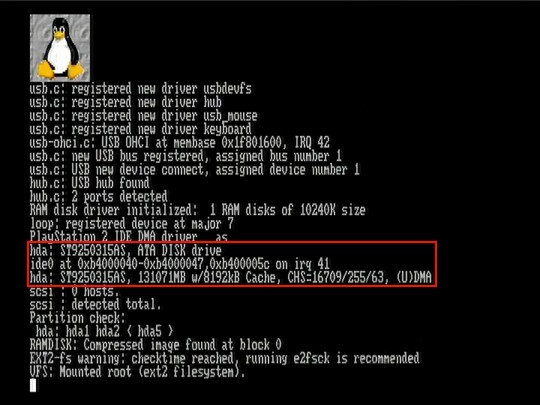
The part highlighted shows Linux detecting my SATA ST9250315AS drive. It's unfortunately locked to 24-bit LBA.
For the hard drive, while not officially supported, it's possible to use any hard drive. This is different from how PS2 software usually works with hard drives, as they require Sony-licensed hard drives that contain MagicGate-compatible firmware installed. This same reason is why it's considered impossible to replace PSX hard drives. The drive will be formatted for Linux and cannot be used for PS2 software at all once Linux is installed. Due to this limitation, the PS2 slim cannot use Linux without modifications to the system.
A PS2 memory card is needed to boot into PS2 Linux, which is where the kernel is installed. Unlike regular PS2 updates though, Linux doesn't boot when you turn on the PS2. You do need Disc 1 to be inserted to start Linux, which I presume was done to prevent people from sharing discs or drives. The memory card will be formatted, but can be used with other saves after installation.
One of the issues with PS2 Linux is that it cannot access CDs or DVDs that aren't pressed PlayStation discs. This is because the PS2 disc drive checks the discs before notifying the system of their presence and refuses to read anything that isn't the standard game, video, or audio disc. It's possible to get around this by patching the MechaCon with MechaPwn to force read everything as a PS2 DVD, but it breaks compatibility with anything that isn't a PS2 DVD until the patch is turned off.
This presented a unique issue for Sony when making Version 1.0. Disc 2 is reserved for system packages and is not meant to boot. If it was a normal data disc, the PS2's disc drive would reject it and make the disc completely inaccessible by the system, so what did Sony do? They pressed it as a regular PS2 DVD, just without the boot files required to actually start it. Since the disc drive sees it as a pressed, legitimate PS2 DVD, it passes it along to the console, which then shows it on the browser. When I launched it, it would lock me up in a boot loop, returning back to the menu which would try to launch it again, which was due to MechaPwn. There's no SYSTEM.CNF file, so the PS2 doesn't know what executable to launch, which there isn't any. On normal consoles, it's been reported that the system just sends you to the red disc error screen.
Another issue is that the original network driver is known to be unstable when using it with later PS2 systems. It's been reported that systems would lock up randomly or it wouldn't establish a connection, so a patch was made for these consoles in particular. When I installed it, it still wouldn't work. I believe it might have to do with the network adapter itself. There's many different versions of the adapter, and we got a unique one in North America that also contained a modem, which might be why the driver isn't working.
While the PS2 was pretty weak as a PC and the Xbox was a far better and more popular solution, many people were more than happy with the low specs if it meant that Linux was an officially supported operating system on a then-current gaming system. Sony's protections with the PS2 made piracy and other things they would worry about practically impossible to achieve on PS2 Linux while also allowing users to screw around with the hardware. After this, Sony continued to support Linux on the PS3 before infamously removing the feature in 2010 which lead to an almost decade-long lawsuit.
If you're interested in seeing the entire install process, I made a video which shows the entire process without any cuts. There's not a lot of videos on the PS2 Linux kit, so this is my contribution.
There's also the Beta Release 1 which I couldn't upload a video for. When I booted it up to NTSC mode, the colors would be messed up when in Linux. It might be a bug or my cables aren't playing well with the software. I'll have to do it another time, but I assume the installation isn't that different.
Despite all of that, not much actually happened. I was mostly focused on upgrading the processor of my PC. I'm in the process of upgrading every component of it, as the last upgrade of anything was in 2019. I bought a new AMD Ryzen 5 5600X, it's the latest Ryzen 5 that's supported by my motherboard.
The upgrade went fine. I updated the BIOS to the latest firmware and plopped in the new processor, then a boot failure occurs. No idea what happened but I switched it back and the BIOS somehow downgraded. It's stupid but I guess it's funny.
Also, Twitter integration for Switch ended this month, I'm guessing due to new API pricing. Nintendo was the last of the major console platforms to remove Twitter integration. You're still able to post on Facebook & USB and hotspot transfers still exist. The features that are avaliable kind of suck though.
I'm not a big fan of having to use hotspot. My setup uses airplane mode, as it removes a noticeable amount of input lag. If I were to use the hotspot, I would have to disable airplane mode, transfer my data, and then undock the system to reenable airplane mode and Bluetooth.
I'm not using the USB feature because that seems mostly for saving entire albums rather than a couple of photos. If I need to transfer a whole album over, I'm not using USB because the transfer speed sucks. I'd rather take the SD card out and copy it from there.
Konami did have a neat idea for screenshots that I think they could copy. In Konami's arcade games, you're able to send screenshots to the e-amusement app, where you could download them for the next 24 hours. It would be neat and seamless, no need to set a wireless connection on your phone or connect a cable, just open the app.
Something like what I explained was implemented in Splatoon 3, where you're able to upload photos to the service. The caveat is that only screenshots from the photo mode can be uploaded, not any captures made in-game. I hope this was some sort of test run to see if the feature would work. It would make the worth it for those who don't play the games that the app supplements.